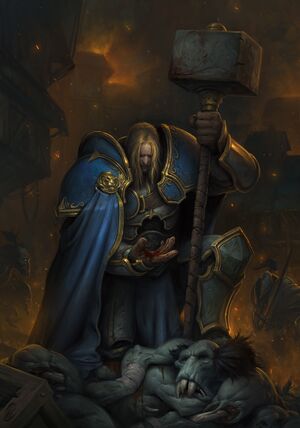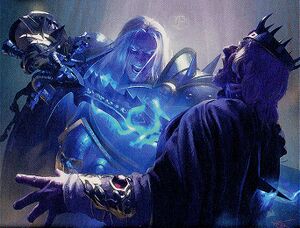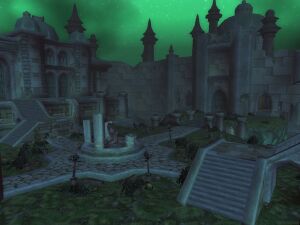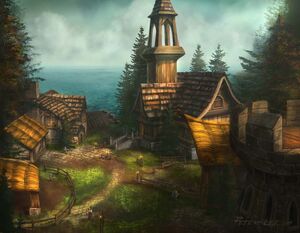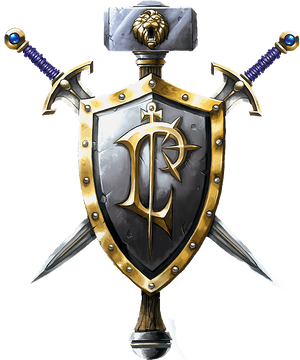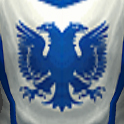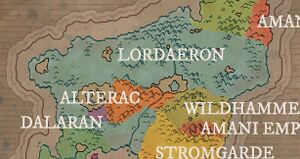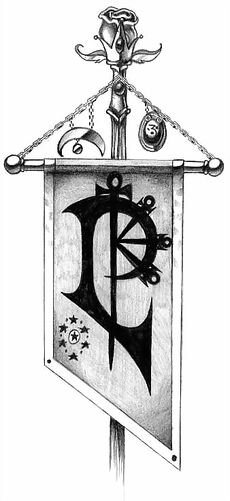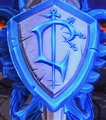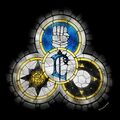User:Wards/Sandbox
- This article is about the fallen human kingdom. For the continent, see Lordaeron. For other uses, see Lordaeron (disambiguation).
|
| |
| Main leader |
|
| Secondary leaders |
|
| Formerly |
|
| Race(s) |
|
| Capital | Capital City |
| Government |
Hereditary monarchy (House of Menethil) |
| Language(s) | Common, Thalassian, Dwarven, Gnomish |
| Affiliation | Alliance of Lordaeron, Church of the Holy Light, Arathorian Empire |
| Status |
Defunct Heavily crippled and subsequently destroyed. Some remnants and survivors allied with or became members of the current Alliance, the Scarlet Crusade, the Argent Dawn, and/or other independent organizations. |
| Reputation | |
| Tabard |
 |
“Noble countrymen, evil is upon us. Darkness has befallen our shores. Rise and slay thy enemies… strike, strike so others shall live. The meek shall not fade into the night… live my brethren, live.”
The Kingdom of Lordaeron[3] (or the Lordaeron Empire)[4] was one of the seven human nations in the Eastern Kingdoms, primarily located along the northern territories of the homonymous continent. Originally an Arathorian city-state founded after the Troll Wars, Lordaeron became an independent kingdom after the empire split apart, and eventually became an empire itself by the time of the Third War. Ruled by the Menethil family, Lordaeron took part in the creation of the eponymous Alliance of Lordaeron and spearheaded the Alliance forces against the Orcish Horde during the Second War.
Unfortunately, the once-glorious kingdom was decimated during the Third War by the Undead Scourge, led by the corrupted Prince Arthas Menethil who murdered his own father, Terenas Menethil II, and unleashed death upon his own people. Following the fall of Capital City, the survivors survivors fled south to Stormwind City, or west to Kalimdor, while those who fell were raised into the ranks of Scourge. Nevertheless, many were later freed from the Lich King's control, and under the command of the Banshee Queen Sylvanas Windrunner, they became known as the Forsaken. Since that time, Lordaeron's territories have been contested between the Forsaken, the survivors of Lordaeron allied to the Alliance, the Argent Crusade, the Scarlet Crusade, and the remnants of the Scourge.
Following the Ascension of the Lich King on the Frozen Throne, Hillsbrad Fields and Southshore were the only Lordaeronian towns that were not left completely devastated by the undead. Both settlements eventually affiliated themselves with the Alliance and remained at peace for several years, until they were ultimately annihilated by the Forsaken following the Cataclysm.
History
Arathorian Empire
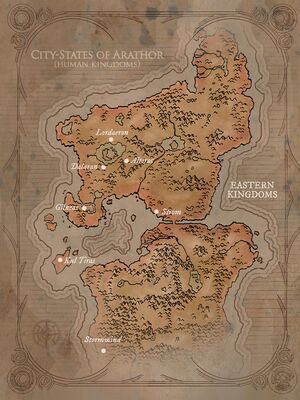
Near the end of the Troll Wars in 2,800 BDP, while King Thoradin and his forces were retreating to Alterac Fortress, the Amani trolls began to gain terrain on the humans fast, threatening to flank and overwhelm Arathor's armies. To avert disaster, General Lordain volunteered to hold back them, knowing he would not survive. Along with his warriors, he died fighting valiantly and their sacrifice secured the victory for the Empire of Arathor and their elven allies of the kingdom of Quel'Thalas. After the war, many of Arathor's soldiers migrated to the fertile lands of Tirisfal Glades where the Arathi established a central stronghold in a region that the veterans renamed as "Lordaeron" in Lordain's honor.[5]
Around 1200 BDP, when the Empire of Arathor split apart into the Seven Kingdoms, many of the noble families of Strom departed in search of purity and enlightenment for the fertile valleys of the north, in which they would found a city-state and named it after the surrounding region. The city-state's borders quickly expanded into those of a proper kingdom, and the nobles renamed the capital of their nation as Capital City. It was also home to religious communes and Light-worshipping ascetics and the state became a mecca for religious pilgrims seeking enlightenment and sick and elderly people seeking healing, allowing it to grow into a proper kingdom.[6][7] Lordaeron's leaders eventually codified the different Light-based traditions and belief systems to create the Church of the Holy Light. The church created a hierarchy of religious leaders to oversee its followers and built temples and shrines throughout the human lands, the most important of which were located in the Eastweald controlled by the kingdom. The oldest and most revered of these holy sites included Light's Hope Chapel, Stratholme, Andorhal, and Tyr's Hand.[8]
The capital city was first an industrial center for the nation, but later, most of the industries were moved east to the new cities of Stratholme and Andorhal, so it became solely an administrative center and was largely remodeled as a wonder of human architecture. But despite its beauty, the city's walls were also sturdy and well-defended, and no foe ever breached them until modern times.[9]
Before the Great Wars
In time, the kingdoms gradually developed rivalries, as before the coming of the orcs, the human kingdoms of Lordaeron faced challenges and obstacles from each other as the games of politics played out.[10] Decades before the First War, while Azeroth enjoyed a time of relative peace, villages squabbled with villages, and kingdoms spied on kingdoms. In the Eastern Kingdoms, humans engaged in rigorous trade with dwarves, gnomes, and high elves. Some nations, like Lordaeron, acted as regional leaders and trendsetters, mediating disagreements between smaller kingdoms and used their strong militaries to impose order over the land. Still, others focused their resources on defending themselves from old rivals.[11]
King Terenas Menethil II's grandfather is said to have had successful negotiations with the high elves of Quel'Thalas over the borders there for his northern vassals.[12]
75 years prior to the First War, King Barathen Wrynn of Stormwind sent envoys to beseech Lordaeron and the other human kingdoms for aid during the Gnoll War. But they would not send assistance, seeing no advantage in helping the smaller, rural nation, as Stormwind was self-sufficient and trade with the other kingdoms was rare.[13]
During the First War, King Llane of Stormwind dispatched messengers to the other human kingdoms, warning of mysterious, fearsome green-skinned invaders. However, no help was received as the reports were not believed. Lordaeron was considered the most likely nation to help. However, Deathwing disguised as a visiting Stormwind noble openly mocked King Llane and claimed the threat was actually a rebellion of disgruntled citizens, causing Lordaeron to only politely wish Llane luck with his troubles.[14]
The Second War
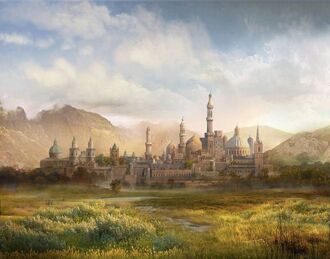
After the kingdom of Stormwind fell to the Orcish Horde, and not long after the dwarven region of Khaz Modan shared the same fate, refugees from Stormwind, led by Anduin Lothar, fled aboard thousands of boats[15] across the sea to the southern shores of the continent of Lordaeron. The Council of Seven Nations was then formed by Lothar and King Terenas Menethil II with the intent of convincing the other human kingdoms to band together to repel the invading orcs. However, divisions widened between the kings, and the arguments grew so heated that Gilneas and Alterac threatened to abandon the council entirely. Nevertheless, this diplomatic incident was avoided when the priest Turalyon presented himself with Prince Varian Wrynn at his side, and delivered an impassioned and charismatic speech of union to the assembly, which got through to even the most doubtful present. The council later voted unanimously to form the Alliance of Lordaeron, comprising all of humanity's kingdoms,[16] as well as the dwarven refugees of Ironforge, the gnomes of Gnomeregan.
Once the Alliance was formed, each king argued in favor of them gaining command of the new unified army. King Terenas pointed out that Lordaeron was the largest kingdom with the most troops, and also that he was the one who had summoned the rest of them. Nonetheless, the Lordaeron monarch later changed his mind and supported Anduin Lothar himself for the role instead,[17] choosing him as a neutral party whose Arathi legacy could also be used to convince the proud high elves of Quel'Thalas to help.[18]
On the battlefields, the knights of Lordaeron represented the fiercest fighting force in the Alliance armies. Protected by suits of heavy armor, they carried mighty warhammers with which to crush all who would threaten the freedom of their lands. Astride great warhorses, these honorable and just warriors served as a symbol of order to the peoples of Lordaeron in these dark and chaotic times. Having learned of the fate the Knights of Azeroth suffered after the First War, they had sworn to both avenge their fallen brethren and free their homelands from the grip of the orcs.[19]
At some point, troubles arose in Tyr's Hand when the local peasant population fell into a state of minor revolt. The Alliance was forced to fight the rebellious peasants. Eventually, the uprising was quelled and the Knights of the Silver Hand were summoned to watch over the populace.[20] It was later discovered that the rebellion was started by Alterac spies in hopes of concealing the orcish mining facility located in the region.[21]
During the Siege of Capital City, King Terenas organized the forces of Lordaeron against the onslaught of the orcs, personally commanding the defenders despite being no warrior himself.[22] He also ordered his guards to try to get all the people and their belongings behind the city walls. The citizens of Lordaeron abandoned their homes with little but the clothes on their backs and tools and other professions they had on them when they fled. They knew their homes would be destroyed, and would have to be rebuilt later.[23] In the end, the defenders' sacrifices were not in vain, as the Alliance forces led by General Turalyon and King Thoras Trollbane arrived to secure victory.[24]
Under the leadership of Supreme Commander Turalyon who succeeded the late Lothar, killed by Warchief Orgrim Doomhammer during the Siege of Blackrock Spire, the Alliance of Lordaeron was victorious in the Second War, pushing the Horde back to the Dark Portal, destroying the gateway to the orcs' homeworld known as Draenor. Shortly after the orcs were defeated, Turalyon spearheaded the efforts to rebuild the Eastern Kingdoms and gathered the kings, who agreed to pool their resources to mend their war-ravaged nations.[25] Special importance was placed on rebuilding the nation of Stormwind, and King Terenas supported Prince Varian's ascension to the throne. However, word of Stormwind's reconstruction was met with mixed feelings by the kingdom's refugees. Many of them refused to return to their broken home as it was a reminder of everything they had lost, and so these refugees preferred to start their lives anew in Lordaeron.[26]
Political unrest
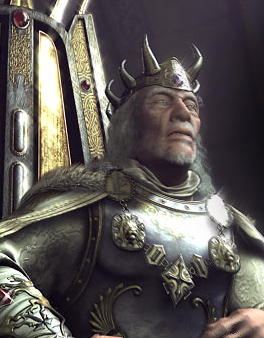
After King Aiden Perenolde betrayed the Alliance of Lordaeron and allied with the orcs, his treachery was eventually discovered, and King Terenas Menethil II declared martial law upon Alterac.[27] Lordaeron also built a military outpost along the borders of the Alterac Mountains, which was raided by the Horde of Draenor and the black dragonflight in order to get the Book of Medivh back from the Alteraci.[28]
Years passed as tensions abated and a lasting peace settled over the kingdom. With his paladins, the Supreme commander Uther the Lightbringer kept the peace in Lordaeron, settling civil disputes and quelling demi-human uprisings throughout the realm,[29] while his apprentice, Arthas Menethil, the heir of Lordaeron, integrated the Order of the Silver Hand at the Cathedral of Light of Stormwind City.[30]
Soon the citizenry of Lordaeron obsessed over the young prince's personal life, notably when rumors of a budding romance between him and Lady Jaina Proudmoore of Kul Tiras had surfaced, setting the kingdom ablaze. Given King Terenas' age and deteriorating health, the citizenry was pleased to see that their beloved prince would marry and carry on the royal bloodline. Embarrassed by the public attention, Arthas and Jaina kept their affair as private as possible, until the two lovers reluctantly parted ways and refocused themselves on their duties, much to the frustration of Lordaeron's citizenry.[31]
During the Alterac crisis, King Thoras Trollbane wanted the traitorous kingdom of Alterac to be split in two between Lordaeron and Stromgarde. However, King Terenas still debated the merits of either annexing Alterac to his own kingdom or setting upon its throne a new and more reasonable monarch, one that would be friendly to Lordaeron.[32] Deathwing, still under the guise of Daval Prestor, manipulated the leaders into making him the future king of Alterac, and even secured a betrothal to Lordaeron's princess, Calia, in order to reinforce his political position. Ultimately, however, Deathwing's plans were foiled when he was defeated at the Battle of Grim Batol and forced into hiding.[33] The kingdom later partially annexed the Alterac Mountains, as at the outset of the Third War, when Arthas Menethil traveled through the King's Road toward Strahnbrad, its inhabitants considered him their lord and took up arms for Lordaeron.[34]
After Archmage Kel'Thuzad returned from Northrend, where he was promised immortality and power for his loyalty to the Lich King, the necromancer preached his new religion to the masses, promising them immortality and an ideal society free of all the burdens the existing one forced upon its citizenry. Many of Lordaeron's overworked laborers and disenfranchised masses were taken in by this charismatic individual, and willingly sold themselves into service to Ner'zhul as members of the Cult of the Damned. Kel'Thuzad also used his fortunes and offers of great powers and immortality to attract and convince nobles and landowners to join his cause, bringing them into the Cult through the promise of using the lower classes to defeat their rivals and obtain even more wealth.[35]
Unaware of the death cults forming in their lands, the nations of the Alliance of Lordaeron began to bicker and argue over territorial holdings and decreasing political influence. The main issue of dispute was a tax levied by King Terenas to finance the internment camps for the orcs. Eventually, the departure of the elven kingdom of Quel'Thalas, who stated that the humans' poor leadership had led to the burning of their forests during the Second War, alongside the liberation of the internment camps by Warchief Thrall, led to the withdrawal of Gilneas and Stromgarde. Though the Alliance was falling apart, Stormwind stood fast in its commitment to Lordaeron, although the distance between both kingdoms made their union a hollow one.[36]
Prior to the Third War, King Terenas feared that Warchief Thrall would soon manage to gather all the remaining renegade orcs hidden in the lands of Lordaeron, which would be critical for the kingdom. He ordered Uther the Lightbringer, the Knights of the Silver Hand, and his son to ride towards southern Lordaeron,[37] in order to deal with them once and for all.[34]
At some point, the kingdom of Stormwind spied on Lordaeron to gain vital information and later to investigate the rumors of the plague of undeath.[38]
Scourging of Lordaeron
“This kingdom shall fall, and from the ashes shall arise a new order that will shake the very foundations of the world.”
- — Arthas Menethil, Champion of the Lich King Ner'zhul
In 20 ADP, after preparing for many long months, the Cult of the Damned finally struck the first blow by releasing the Plague of Undeath upon Lordaeron. When the Dalaranian ambassador to King Terenas Menethil II revealed that the Kirin Tor were prepared to place the villages under strict quarantine, the king, however, declared that there would be no quarantine without proof of these claims as its people had suffered enough.[39] In the meantime, Uther the Lightbringer and his fellow paladins investigated the infected regions in the hope of finding a way to stop the plague. Despite their efforts, the plague continued to spread and threatened to tear the Alliance of Lordaeron apart.[40]
At the beginning of the Third War, Prince Arthas Menethil and Jaina Proudmoore investigated the strange disease. They eventually encountered the necromancer Kel'Thuzad in the town of Brill and pursued him to Andorhal,[41] where had already infected the town's stored grain and shipped it out to outlying villages. Before Arthas killed him, Kel'Thuzad revealed that the nathrezim Mal'Ganis was the mastermind behind this invasion, and that the demon was hiding in Stratholme.[42]
As the epidemic progressed, the city of Hearthglen was about to be attacked by an army of undead, and the defenders had just baked and eaten the infected grain of Andorhal before the battle. Along with the soldiers of Lordaeron's army, Prince Arthas, who had tracked the shipment of grain to Hearthglen, was able to slay those infected before they could spread the disease to the entire town. Shortly thereafter, the undead army laid siege to the town and the Lordaeronian forces held them off long enough for the arrival of Uther and the Knights of the Silver Hand to claim victory.[43]
When they arrived at Stratholme, the infected grain had already been distributed and Arthas knew his people would soon become undead. When Uther refused to purge the entire city, the prince proclaimed that he had committed treason and suspended the paladins from service, while those who remained loyal joined him in slaughtering the infected citizens. During the massacre, Mal'Ganis appeared and began "collecting" the mindless zombies, gloating that soon the people of Lordaeron would belong to the Scourge. The two sides proceeded to ravage the city building by building in a macabre race for the lives of the townsfolk. Some citizens were killed in their sleep,[44] others after their zombification, some were executed while still human and trying to flee, and some tried to fight back. Many also took their own lives, opting to hurl themselves into the myriad flames of the smoldering city rather than become one of the Scourge.[45] In the end, Arthas confronted Mal'Ganis to end this madness, only for the demon to teleport away after telling the prince to gather his forces and come for him to Northrend.[46] After Stratholme was purged, some former paladins, now called Deathlords, committed the same heinous act in many other cities across Lordaeron.[47]
Despite the high elves' official departure from the Alliance, some elves still remain true to their former human and dwarven allies. The altruistic priests of Quel'Thalas refused to abandon their roles as healers and agreed to remain in Lordaeron despite the edicts from their reclusive masters in Silvermoon. They use their Light-given powers to heal the wounded and bolster the spirits of Lordaeron's fighting elite.[48] The Wildhammer dwarves also brought the gryphons of Aerie Peak to aid the Alliance in its time of need and sought to keep the skies of Lordaeron free from enemy forces.[49]
In time, the 1st Legion accompanied Prince Arthas in his quest to destroy Mal'Ganis. However, upon arriving to Northrend, King Terenas's emissary came and ordered the expedition to return to Lordaeron, but Arther refused to stop until he avenged his people. After he burned down his ships, he eventually found the mourneblade Frostmourne and used it to destroy the dreadlord. His objective accomplished, Arthas fled to the wilderness of Northrend where he lost the rest of his humanity, becoming a death knight. When he returned to the base camp, he slaughtered his men, raising them as mindless Scourge and death knights.[50] Afterward, Valgarde became the first home of the lucky few who survived Arthas' betrayal.[51]
At the same time, the undead mysteriously vanished from the Eastweald. Most of the citizens thought that this meant Arthas had succeeded in destroying the Scourge in Northrend. In truth, the Lich King had ordered his forces to pull back in order to make the population believe that Arthas had defeated the undead and trick them into welcoming him back with open arms.[52] When he returned to Lordaeron months later, the kingdom rejoiced at the return of its champion. Within the Imperial chamber, the corrupted prince walked up to his father and ran Frostmourne through his heart.[53] He then then unleashed the Scourge upon the Capital City, while his lieutenants Falric and Marwyn were responsible for the slaughter of the aristocracy.[54] Thus, in an ironic twist of fate, it was Lordaeron that lay in ruins, with refugees streaming to Khaz Modan and Azeroth.[55] After Capital City fell, the Scourge army swept across Lordaeron. Neighboring human and dwarven nations converged on Lordaeron to vanquish the Scourge. However, the undead were numerous and defeated any resistance, and ultimately took Lordaeron.[56]
At the same time, King Genn Greymane barricaded his people behind the Greymane Wall; no one, not even human refugees were allowed to enter. The king of Gilneas even refused to help Lordaeron, who weeks before had begged the neighboring nation for help. He saw the fall of Lordaeron as confirmation that he had made the right choice in isolating his realm from the world.[57]
Prior to the Siege of Dalaran, Lady Jaina Proudmoore worked tirelessly to rally as many refugees as she could after she had been convinced by the mysterious Prophet that sailing west to Kalimdor was the only course to save humanity. When she set sail for Kalimdor, her forces included members from nearly every Alliance race, including survivors from Lordaeron and other nations in the region.[58] The Human Expedition was also accompanied by the Lordaeron Brigade and the Lordaeron Corps.[59]
Some Lordaeron refugees still managed to get to Stormwind City. Mathias Shaw and Flynn Fairwind believe that refugees of Lordaeron must have wanted a way to honor their fallen king, so they buried Terenas Menethil II's crown in an unmarked grave at the lighthouse in Stormwind Harbor.[60]
Rise of the Lich King
After the massacre of its citizens and its destruction, Capital City soon came to be called the Ruins of Lordaeron and was overseen by the dreadlords Balnazzar, Detheroc, and Varimathras. Several months after the Battle of Mount Hyjal, detachments of the surviving paladins of the Order of the Silver Hand emerged from the rubble of the Lordaeron to form a resistance against the Scourge and protect the survivors. However, their combined efforts were not enough, as they were defeated by Arthas Menethil, Kel'Thuzad, and Sylvanas Windrunner on their return from Kalimdor, allowing the Scourge to murder the survivors and destroyed the resistance. Following his victory, Arthas ousted the dreadlords of the ruined city and named himself King of Lordaeron.[61]
Meanwhile, the remnants of the Alliance in Lordaeron banded together to form the Alliance resistance in order to retake their lost lands from the undead. Under the command of Grand Marshal Garithos, they managed to retake Dalaran.[62] However, Garithos' harsh bigoted leadership forced the blood elves to desert his army[63][64][65] and sometime later, the Alliance resistance was mind controlled by the Dreadlord Insurgents. In time, the Plaguelands civil war erupted between his forces, the remaining dreadlords, and the free undead (later known as the Forsaken) led by Sylvanas Windrunner. While Arthas was summoned to Northrend to defend the Lich King, Windrunner's forces, with the help of Varimathras, freed the Alliance resistance from the dreadlords' influence,[66] and together, they worked to take down the last dreadlord warlord, Balnazzar, and retake the Ruins of Lordaeron. Instead of leaving Lordaeron as she promised however, the Banshee Queen betrayed Garithos and had him and his men killed. Afterwards, they claimed the Ruins of Lordaeron, under which they inhabited the Undercity.[67]
In Nothrend, Arthas raced against Illidan Stormrage and Kael'thas Sunstrider to reach the Frozen Throne before they could destroy it. After defeating all those who stood in his way, Arthas ascended to the top of Icecrown Citadel where he shattered Ner'zhul's icy prison with Frostmourne. The fallen prince then picked up Helm of Domination, placed it upon his head, and merged with his master.[68]
The paladins who remained in Lordaeron continued to fight against the Scourge. From their base at Hearthglen, they were able to gain some victories against the Lich King's forces,[69] and also made an alliance with Lord Valdelmar of Tyr's Hand, extending their protection to the fortified city from daily attacks of the undead.[70] Following Alexandros' assassination, the possessed Saidan Dathrohan reorganized what remained of the Silver Hand in Lordaeron into the Scarlet Crusade. These paladins strove fanatically to destroy evil, without any regard for the means used, and despised all non-human races. Other paladins disgusted with the Crusaders' immoral zealotry left to form the Argent Dawn, which took a less extreme approach by remaining faithful to the principles of the Light and accepted members from all of Azeroth's races into their ranks.[71] At Light's Hope Chapel, Lord Maxwell Tyrosus and a few others were chosen for the secret task of unearthing the bodies of a thousand fallen heroes across Lordaeron, bringing them to be interred once more in sacred ground, in order to protect the honored dead from being raised into the Lich King's undead army.[69]
Aftermath
In the aftermath of the Third War, the balance of power among the human kingdoms shifted. With Lordaeron's fall and the devastation of the northern kingdoms, the kingdom of Stormwind arose as a new bastion of leadership and military might in the Alliance. This granted the kingdom immense prestige and influence on the world stage,[72] while Stormwind City became the new base of the faction. Meanwhile, the fallen kingdom's territories became the center of conflicts between several factions, including the remnants of Lordaeron allied to the Alliance, the Scarlet Crusade, the Forsaken, the Argent Dawn (later the Argent Crusade), and the Scourge.
Two years after the fall of Lordaeron, Tarren Mill was still inhabited by humans and in a pristine state. It was later attacked by the traitor high elf Dar'Khan Drathir and his undead, looking for the essence of the Sunwell.[73]
In 24 BDP, the Scarlet Crusade patroled the remaining villages of Lordaeron, checking if their citizens were infected by the Plague of Undeath. On one such patrol, the possessed Saidan Dathrohan and Sir Thomas led a group of crusaders into a village, which was deemed corrupted by the Grand Crusader, and slew all the townsfolk. Such massacres were repeated numerous times in the years that followed.[74]
World of Warcraft
Among the remnants of Lordaeron, Hillsbrad Fields and Southshore were the only towns that were not left completely devastated by the undead, while Tarren Mill fell at some point at the hands of the Forsaken. As such, guards from both communities were still wearing the tabard of their former kingdom. Since they were not affiliated with any distinct Alliance nation, but have sworn fealty to the monarchs of Stormwind and Ironforge, the people of Hillsbrad had to pay taxes to those kingdoms in order to sustain the Alliance's upkeep.[75]
At some point, refugees from Lordaeron and neighboring lands, under the care of Dalin Forgewright, tried to enter Gilneas but were stopped by the then-closed Greymane Wall.[76] Those refugees were not killed when the Scourge rampaged the land, and were presumably killed by the Forsaken and the worgen of Shadowfang Keep before the invasion of Gilneas.
In terms of threats, the people of Southshore had conflicts with the Forsaken in Tarren Mill, the Crushridge ogres settling in the Alterac Mountains,[77][78] and the Syndicate at Durnholde Keep, who stole their horses and shipments of crystals.[79][80] Magistrate Henry Maleb seemed convinced that the Syndicate were scheming Southshore's destruction and had previously assassinated the former magistrate, he thus requested aid from any adventurer to help in Southshore's retaliation.[81]
Meanwhile, Hillsbrad Fields was led by Magistrate Burnside and its people were constantly threatened by the Forsaken forces of High Executor Darthalia at Tarren Mill. When the time was right, Arch Lord Varimathras had Darthalia wage war on them so that they could quell humanity and buy their apothecaries enough time to develop the New Plague. Peasants, farmers, landowners, and other members of the human supply line and infrastructure were especially threatened.[82] Nonetheless, the Hillsbrad townspeople were very capable of fighting back, they organized themselves into a militia and staged ambushes on the undead forces.[83] Afterwards, the Horde began to attack the Hillsbrad leadership[84] and their mining operations in Azurelode Mine.[85]
The Battle for Hillsbrad eventually escalated into a battleground between the towns of Southshore and Tarren Mill. Consequently, Alliance and Horde adventurers frequently clashed in full-blown skirmishes in this notorious conflict.[86]
Cataclysm
Following the Cataclysm, Southshore was destroyed by the Forsaken on the orders of Sylvanas Windrunner, who used their Forsaken Blight on the town, leaving it blighted and in ruins.[87] The surviving residents, including Magistrate Henry Maleb and their leadership, eventually fled to Fenris Isle in neighboring Silverpine Forest. At Fenris Keep, most of the Southshore leaders became worgen after drinking the blood of Ivar Bloodfang, rendering themselves immune to undeath and joining forces with the Gilneas Liberation Front to retake Lordaeron and Gilneas for the Alliance.[88] The worgen continued to make their blood offering to every surviving human in Lordaeron, resulting in hundreds of new recruits to bolster their ranks, and they openly fought with the Forsaken forces afterwards.[89]
The Hillsbrad Fields were also targeted by the Forsaken who seized and transformed the lands into Sludge Fields. Before the attack, Magistrate Burnside and a few dozen Hillsbrad residents stayed behind to defend the town but were ultimately defeated, imprisoned, and experimented on by the mad Warden Stillwater. Nonetheless, some Hillsbrad humans fled either to the Arathi Highlands — in which they ended up slaughtered before reaching Thoradin's Wall — or north into the Silverpine Forest — where they found sanctuary in Fenris Keep and joined up with the survivors and worgen.[90] The human survivors in Azurelode Mine were held as captives by the Forsaken and later sent to the Sludge Fields when needed.[91]
Before the Storm
Following the Argus Campaign, High King Anduin Wrynn met Calia Menethil during a meeting at the Netherlight Temple. The king of Stormwind was shocked and relieved to know she had survived the Third War, and considered her the rightful queen of Lordaeron.[92] However, Calia later stated that she had no intention of reclaiming the throne of Lordaeron, as she considered the Forsaken as the true heirs of the ruined kingdom.[93]
During the Gathering in the Arathi Highlands, a historical event that allowed people of Stormwind and Lordaeron to meet their relatives of the Undercity, several Forsaken attempted to defect to the Alliance forces at Stromgarde Keep. As the heir to the throne, Calia decided that she had to take responsibility for leading the people of Lordaeron and tried to convince the other Forsaken to join her. However, after being made aware of her existence, Warchief Sylvanas Windrunner personally flew through the field and murdered the princess, who she saw as a threat to her authority, while her dark rangers killed all the fleeing Forsaken.[94]
After she was raised as an undead touched by the Light, Calia explained to Anduin that while she did not wish for a bloodbath nor reassert her claim to Lordaeron, she could not stand by and let the Banshee Queen butcher her people out of jealousy. Seeing the Forsaken as her people, Calia had followed her heart on the field to accept them as her responsibility but also acknowledged that she was not yet ready to lead as she hadn't been the heir to the throne.[95] The Forsaken victims were later buried by their families and friends a few days after the tragic event, with the help of stone carvers and gravediggers brought by King Anduin.[96][97]
Battle for Azeroth
In the aftermath of the Fourth War, the Scarlet Brotherhood made a number of spurious claims through propaganda pamphlets, including that King Anduin Wrynn and Sylvanas Windrunner orchestrated the Gathering in order to lure out, kill and raise Calia Menethil into undeath, allowing Anduin to marry her and usurp the throne of Lordaeron.[98][99] They also stated that the Brotherhood had secretly raised the "son" of Princess Calia and an Arathi nobleman and therefore the rightful king of Lordaeron[100] (apparently ignoring the fact that Calia's actual child was a daughter with a common footman, not a son with a nobleman).[101] The zealots then promised that they would reveal this so-called Menethil heir and place him on the throne after the undead and worgen have been wiped from the land, thereby restoring the Menethil dynasty.[100]
People and culture
Something originating from Lordaeron is called "Lordaeronian".[102]
The kingdom's national colors are both white and blue.[103][104] In Warcraft III: Reign of Chaos, Lordaeron forces were represented in blue (white is notably not a playable color as it was in Warcraft II). In Warcraft III: The Frozen Throne, Lordaeron was instead most commonly represented as a light blue. Along with the Lordaeron sigil, both twin[104] and single-headed[105] eagles often adorn its banners and tabards. Lions are also a common symbol.[106]
Like the other realms, the kingdom of Lordaeron applied the death penalty for its criminals, the task being accomplished by an executioner, including hanging as gallows were present in their cities, such as Stratholme. After his excommunication, Tirion Fordring mentioned that he would, in turn, be hanged for his treason by saving Eitrigg from his execution.[107] The court of King Terenas employed Wroth as a royal torturer.[108] The town of Southshore had its own court and tribunal, and allowed the death penalty by hanging.[109]
When the Knights of the Silver Hand obtain their steed, they name it by a quality they admire, following the informal tradition inherited from the knights and nobles of Lordaeron.[110][111]
Faith and folklore
Lordaeronians revere the Holy Light, and the Church of the Holy Light played a significant role in Lordaeron society. Centuries ago, Lordaeron's leaders codified the different Light-based traditions and belief systems. From these efforts, the Church of the Holy Light came to be. Lordaeron served as the home of this church and became a popular destination for travelers seeking healing, wisdom, and inner peace. The church constructed temples and shrines throughout the far-flung human lands, and it created a hierarchy of religious leaders to oversee its followers. The most important places of worship were located in the verdant Eastweald. Among the oldest and most revered of these holy sites were Light's Hope Chapel, Stratholme, Andorhal, and Tyr's Hand.[8] Thus, the armies of Lordaeron were said to be deeply religious.[112] The Old Monastery of Tirisfal Glades was once a proud bastion of Lordaeron's priesthood, a center for learning and enlightenment,[113] which also served as a seminary and major training ground for paladins in training.[114][115]
Each year, the people of Lordaeron celebrated many holidays and events, notably the Feast of Winter Veil which was introduced to Lordaeron and the Alliance at large by Muradin Bronzebeard,[116] thus its cities were accordingly decorated for the occasion. During the Noblegarden, it was customary for the nobles and lords of Lordaeron to hide coins, candy, and the occasional treasures within special eggs painted to look like wildflowers, which are then scattered in the capital and towns for the citizenry to find.[117]
Hallow's End was also celebrated in Lordaeron. It was a peasant ritual, sprung up from time immemorial, with several smaller festivals leading up to it. One was somber, one was celebratory, and this one was a bit of both. It was believed to be a time when the barrier between the living and the dead was thin, and those who had passed on could be sensed by those still alive. Tradition had it that at the end of the harvest season, before the winds of winter began to blow, that a straw effigy would be erected right outside the Lordaeron's palace. At sunset on the night of the ceremony, it would be lit on fire. Anyone who wished could approach the fiery effigy, toss a branch into the cracking flames, and in so doing metaphorically “burn away” anything they did not wish to carry into the quiet, deep reflection time provided by winter's enforced inactivity, such as negative emotions like fears or sorrows.[118]
Lordaeronian lullaby
- Lu, la lu, my dearest child,
- Lu, la lu, lu la lay,
- Lordaeron says, "Go to sleep."
- Azeroth says, "Dream you deep."
- Lu, la lu, la lu, la lay,
- Safe in my arms you'll stay.[119]
Notable people
Notable leaders
| History | Before the Dark Portal | Interlude | Aftermath | ||||||||||||||||||
|---|---|---|---|---|---|---|---|---|---|---|---|---|---|---|---|---|---|---|---|---|---|
| Ruler | King Terenas Menethil II | King Arthas Menethil | None | ||||||||||||||||||
Military
| This section is a lore stub. |
- Sergeant Morigan
- Lordaeron Citizen - Undercity
- Southshore Guard - Hillsbrad Foothills
- Hillsbrad Sentry - Hillsbrad Foothills
- Lordaeron Commander - Eastern Plaguelands
- Lordaeron Soldier - Eastern Plaguelands
- Lordaeron Veteran - Eastern Plaguelands
- Lordaeron Fighter - Eastern Plaguelands
- Lordaeron Sentry - Old Hillsbrad Foothills

- Lordaeron Watchman - Old Hillsbrad Foothills

- Forgotten Knight - Dragonblight

- Forgotten Footman - Dragonblight

- Lordaeron Crier - Culling of Stratholme

- Lordaeron Footman - Culling of Stratholme

- Lordaeron Knight - Culling of Stratholme

- Lordaeron Captain - Icecrown

- Lordaeron Footsoldier - Icecrown

- Phantom Swordsman - Icecrown Citadel

See also: Durnholde military, 1st Legion
Territories and outposts
By the time of the Third War, the kingdom of Lordaeron controlled northern Lordaeron, the Eastweald, the Tirisfal Glades, the northern part of Silverpine Forest, the majority of the Hillsbrad Foothills and parts of the Alterac Mountains (including Chillwind Point and Strahnbrad).
- Northern Silverpine Forest
- Majority of Hillsbrad Foothills
- Northeastern Alterac Mountains
Items
 [Havoc's Call, Blade of Lordaeron Kings]
[Havoc's Call, Blade of Lordaeron Kings] [Royal Crest of Lordaeron]
[Royal Crest of Lordaeron] [Ruined Crest of Lordaeron]
[Ruined Crest of Lordaeron] [Lordaeron Lambic]
[Lordaeron Lambic]
In Warcraft II
Leader: King Terenas
Nation Color: White
Background: Ruled by the benevolent King Terenas, the nation of Lordaeron stands as the last bastion of hope for humanity. The armies of Lordaeron were the first to heed the call to arms issued by Sir Lothar and the people of Azeroth. As patron of the Alliance, King Terenas has assumed the heavy mantle of leadership to protect all who abide in his domain. The armies of Lordaeron are deeply religious and are driven by the belief that humanity must stand steadfast against the blasphemous onslaught of the Horde.[120]
Film universe
Lordaeron participated in the council that would eventually lead to the creation of the Alliance.
Notes and trivia
- In Deathwing's mind, Lordaeron wine represented the only worthwhile export the kingdom offered.[121]
- The Balnir Farmstead was known for breeding the great white horses of Lordaeron that were regularly bought as mounts by the royal household.[122][123]
- The Lordaeron symbol is present on
 [High Warlord's Shield Wall], representing the Forsaken and their Lordaeronian heritage. It is also present on the Forsaken heritage armor, the Heritage of Lordaeron.
[High Warlord's Shield Wall], representing the Forsaken and their Lordaeronian heritage. It is also present on the Forsaken heritage armor, the Heritage of Lordaeron. - In an alternate universe where Aedelas Blackmoore became king of Lordaeron after he overthrew King Terenas Menethil II, Prince Arthas Menethil fled southward with his Jaina Proudmoore and son to the kingdom of Stormwind, where he and King Varian Wrynn were planning to strike on Lordaeron. Thus no Scourge, nor Forsaken were ever created.[124]
- During the Legion beta, Calia Menethil said the kingdom of Lordaeron no longer existed. This never made it into the live version of the game.[125]
- While people from Lordaeron usually speak with American accents, the Scarlet Crusade in the Mists of Pandaria revamp of Scarlet Monastery and Scarlet Halls have German accents. No other Lordaeronians share this accent, and the Scarlet Crusade has not used it in appearances after this either.
Gallery
The lands of Lordaeron in Warcraft III.
The continent of Lordaeron in the World of Warcraft: Game Manual.
Lordaeron on the shores of Lordamere Lake during the times of Arathor.
The lands of Lordaeron (in cyan) and the rest of the Eastern Kingdoms before the First War.
Lordaeron and Khaz Modan during the Third War.
Scourge of Lordaeron Human campaign menu in Reforged.
Shield seen on a motorbike in Heroes of the Storm.
- Fan art
See also
References
- ^ Arthas: Rise of the Lich King, chapter 3
- ^ Warcraft III - Maps - Bonus Maps - Classic Battle.net
- ^ Hearthstone - Uther Lightbringer, The Paladin
- ^ King Arthas (WC3 Undead) - Quest "Slay the Paladins": "The Paladin order has emerged again from the rubble of the Lordaeron Empire."
- ^ World of Warcraft: Chronicle Volume 1, pg. 133
- ^ World of Warcraft: Chronicle Volume 1, pg. 141
- ^
 [The Seven Kingdoms]
[The Seven Kingdoms]
- ^ a b World of Warcraft: Chronicle Volume 2, pg. 126
- ^ Tides of Darkness, chapter 16
- ^ Arthas: Rise of the Lich King, pg. 27 & 31
- ^ World of Warcraft: Chronicle Volume 2, pg. 105 - 106
- ^ Day of the Dragon, pg. 82
- ^ World of Warcraft: Chronicle Volume 1, pg. 160
- ^ World of Warcraft: Chronicle Volume 2, pg. 124
- ^ Tides of Darkness, first prologue
- ^ World of Warcraft: Chronicle Volume 2, pg. 152 - 153
- ^ Tides of Darkness, chapter 5
- ^ Tides of Darkness, chapter 7
- ^ Warcraft II: Tides of Darkness manual, Alliance Ground Units, Knight
- ^ Tyr's Hand (WC2 Human)
- ^ Betrayal and the Destruction of Alterac (WC2 Human)
- ^ Tides of Darkness, pg. 266-268
- ^ Tides of Darkness, pg. 265
- ^ Tides of Darkness, pg. 282 - 286
- ^ World of Warcraft: Chronicle Volume 2, pg. 176
- ^ World of Warcraft: Chronicle Volume 2, pg. 177
- ^ Tides of Darkness, pg. 373
- ^ Alterac (WC2 Orc)
- ^ Warcraft III: Reign of Chaos Game Manual, pg. 6
- ^ Arthas: Rise of the Lich King, pg. 45 - 47
- ^ Warcraft III: Reign of Chaos Game Manual - A New Generation
- ^ Day of the Dragon, chapter 1
- ^ World of Warcraft: Chronicle Volume 3, pg. 23
- ^ a b The Defense of Strahnbrad (WC3 Human)
- ^ World of Warcraft: Chronicle Volume 3, pg. 30
- ^ Warcraft II: Beyond the Dark Portal manual, The Aftermath of the Second War
- ^ Arthas: Rise of the Lich King, part 2, chapter 8
- ^ Traveler: The Spiral Path, chapter 17
- ^ The Warning
- ^
 [The Scourge of Lordaeron]
[The Scourge of Lordaeron]
- ^ Ravages of the Plague
- ^ The Cult of the Damned
- ^ World of Warcraft: Exploring Azeroth: The Eastern Kingdoms, pg. 74
- ^
 [A Careworn Note]
[A Careworn Note]
- ^
 [60D] The Restless Souls
[60D] The Restless Souls
- ^ The Culling (WC3 Human)
- ^ Shield of the Deathlord
- ^ Warcraft III: Reign of Chaos - manual, 10
- ^ Warcraft III: Reign of Chaos manual, Human Units, Gryphon Rider
- ^ World of Warcraft: Chronicle Volume 3, pg. 52
- ^ Exploring Azeroth: Northrend, pg. 18
- ^ World of Warcraft: Chronicle Volume 3, pg. 54
- ^ Arthas' Betrayal
- ^ Death Knight (manga)
- ^ World of Warcraft: Game Manual, pg. 168
- ^ World of Warcraft: Chronicle Volume 3, pg. 54 - 55
- ^ World of Warcraft: Chronicle Volume 3, pg. 60
- ^ World of Warcraft: Chronicle Volume 3, pg. 65
- ^ Where Wyverns Dare (WC3 Orc)
- ^ World of Warcraft: Exploring Azeroth: The Eastern Kingdoms, pg. 121
- ^ King Arthas (WC3 Undead)
- ^ Misconceptions (WC3 BloodElf)
- ^ The Warcraft Encyclopedia/Blood Elves
- ^ The Dungeons of Dalaran (WC3 BloodElf)
- ^ The Crossing (WC3 BloodElf)
- ^ Dreadlord's Fall (WC3 Undead)
- ^ A New Power in Lordaeron (WC3 Undead)
- ^ The Ascension
- ^ a b World of Warcraft: Ashbringer, Issue 4 - Dust to Dust
- ^ Ashes to Ashes, pg. 4 & 16
- ^ Ashes to Ashes
- ^ World of Warcraft: Chronicle Volume 3, pg. 115
- ^ Dragon Hunt
- ^ A Cleansing Fire
- ^
 [Hillsbrad Town Registry]
[Hillsbrad Town Registry]
- ^

 [20] Hearts of the Pure
[20] Hearts of the Pure
- ^
 [36] Crushridge Bounty
[36] Crushridge Bounty
- ^
 [40G] Crushridge Warmongers
[40G] Crushridge Warmongers
- ^
 [34] Costly Menace
[34] Costly Menace
- ^
 [29] Missing Crystals
[29] Missing Crystals
- ^
 [33] Syndicate Assassins
[33] Syndicate Assassins
- ^
 [24] Battle of Hillsbrad
[24] Battle of Hillsbrad
- ^
 [28] Dangerous!
[28] Dangerous!
- ^
 [26] Battle of Hillsbrad
[26] Battle of Hillsbrad
- ^
 [28] Battle of Hillsbrad
[28] Battle of Hillsbrad
- ^ Southshore vs Tarren Mill
- ^
 [7-30] Studies in Lethality
[7-30] Studies in Lethality
- ^
 [5-30] No Escape
[5-30] No Escape
- ^
 [5-30] The Waters Run Red...
[5-30] The Waters Run Red...
- ^
 [The Battle for Hillsbrad]
[The Battle for Hillsbrad]
- ^
 [7-30] Human Infestation
[7-30] Human Infestation
- ^ Before the Storm, chapter 9
- ^ Before the Storm, chapter 24
- ^ Before the Storm, chapter 31
- ^ Before the Storm, chapter 35
- ^ Before the Storm, epilogue
- ^ World of Warcraft: Exploring Azeroth: The Eastern Kingdoms, pg. 72
- ^
 [The Traitor King]
[The Traitor King]
- ^
 [The Would-Be Queen]
[The Would-Be Queen]
- ^ a b
 [The Last Menethil]
[The Last Menethil]
- ^ Before the Storm, chapter 25
- ^ Sean Copeland on Twitter: "Lore from Chris Metzen and Micky Neilson! Alteraci (“alterackee”), Lordaeronian, Stromic, Dalaranian, Stormwindian. BOOM." March 10, 2014
- ^ Lordaeron bicolor banners in Warcraft III
- ^ a b Old Hillsbrad Foothills and Culling of Stratholme NPCs' tabards and banners
- ^ Atop Lordaeron banners in Warcraft III
- ^ Adorning Arthas Menethil's armor in-game as well as found on flags and embossed in gold in the human campaign screen of Warcraft III.
- ^ Of Blood and Honor, chapter 7
- ^
 [15-30] The Rod of Compulsion
[15-30] The Rod of Compulsion
- ^ Legends Volume 4: Blood Runs Thicker
- ^ Arthas: Rise of the Lich King, pg. 26
- ^ Exploring Azeroth: The Eastern Kingdoms, pg. 107
- ^ Warcraft II: Tides of Darkness manual, Nations of the Alliance, Lordaeron
- ^ Game Guide/World Dungeons#The Scarlet Monastery
- ^
 [38D] Mythology of the Titans
[38D] Mythology of the Titans
- ^
 [30D] The Scarlet Monastery
[30D] The Scarlet Monastery
- ^ Arthas: Rise of the Lich King, chapter 8
- ^ Noblegarden's event description
- ^ Arthas: Rise of the Lich King, chapter 7
- ^ Before the Storm, chapter 20
- ^ Warcraft II: Tides of Darkness manual, Nations of the Alliance, Lordaeron
- ^ Day of the Dragon, chapter 13
- ^ Arthas: Rise of the Lich King, chapter 1
- ^ Exploring Azeroth: The Eastern Kingdoms, pg. 106
- ^ Thrall: Twilight of the Aspects, chapter 10
- ^

 [100] Agent of Aid. "And I'm just Calia now, Lordaeron is no more."
[100] Agent of Aid. "And I'm just Calia now, Lordaeron is no more."
| |||||||||||||||||||

